Soil Management and Slope Impacts on Soil Properties, Hydrological Response, and Erosion in Hazelnut Orchard
Abstract
:1. Introduction
2. Materials and Methods
2.1. Study Area and Climate
2.2. Experimental Design, Rainfall Simulation Experiments, and Soil Sampling
2.3. Laboratory Analyses
2.4. Statistical Analyses
3. Results
3.1. Soil Properties
3.2. Hydrological Response and Soil Erosion
3.3. Principal Component Analysis
4. Discussion
5. Conclusions
Supplementary Materials
Author Contributions
Funding
Institutional Review Board Statement
Informed Consent Statement
Data Availability Statement
Acknowledgments
Conflicts of Interest
References
- Bai, Z.G.; Dent, D.L.; Olsson, L.; Schaepman, M.E. Proxy global assessment of land degradation. Soil Use Manag. 2008, 24, 223–234. [Google Scholar] [CrossRef]
- Keesstra, S.; Pereira, P.; Novara, A.; Brevik, E.C.; Azorin-Molina, C.; Parras-Alcántara, L.; Cerdà, A. Effects of soil management techniques on soil water erosion in apricot orchards. Sci. Total Environ. 2016, 551, 357–366. [Google Scholar] [CrossRef] [Green Version]
- Kisic, I. Antropogena Erozija Tla, 1st ed.; Grafički Zavod Hrvatske d.d.: Zagreb, Hrvatska, 2016; p. 18. [Google Scholar]
- Blanco, H.; Lal, R. Soil and water conservation. In Principles of Soil Conservation and Management; Springer: Berlin/Heidelberg, Germany, 2008. [Google Scholar]
- Prosdocimi, M.; Cerdà, A.; Tarolli, P. Soil water erosion on Mediterranean vineyards: A review. Catena 2016, 141, 1–21. [Google Scholar] [CrossRef]
- Sinkevičienė, A.; Jodaugienė, D.; Pupalienė, R.; Urbonienė, M. The influence of organic mulches on soil properties and crop yield. Agron. Res. 2009, 7, 485–491. [Google Scholar]
- Olson, N.C.; Gulliver, J.S.; Nieber, J.L.; Kayhanian, M. Remediation to improve infiltration into compact soils. J. Environ. Manag. 2013, 117, 85–95. [Google Scholar] [CrossRef]
- Bogunovic, I.; Telak, L.J.; Pereira, P.; Filipovic, V.; Filipovic, L.; Percin, A.; Durdevic, B.; Birkás, M.; Dekemati, I.; Rodrigo-Comino, J. Land management impacts on soil properties and initial soil erosion processes in olives and vegetable crops. J. Hydrol. Hydromech. 2020, 68, 328–337. [Google Scholar] [CrossRef]
- Liu, H.; Blagodatsky, S.; Giese, M.; Liu, F.; Xu, J.; Cadisch, G. Impact of herbicide application on soil erosion and induced carbon loss in a rubber plantation of Southwest China. Catena 2016, 145, 180–192. [Google Scholar] [CrossRef]
- Valmis, S.; Dimoyiannis, D.; Danalatos, N.G. Assessing interrill erosion rate from soil aggregate instability index, rainfall intensity and slope angle on cultivated soil in central Greece. Soil Till. Res. 2005, 80, 139–147. [Google Scholar] [CrossRef]
- Gabet, E.J.; Dunne, T. Sediment detachment by rain power. Water Resour. Res. 2003, 39, ESG-1. [Google Scholar] [CrossRef]
- Xu, Q.X.; Wang, T.W.; Cai, C.F.; Li, Z.X.; Shi, Z.H.; Fang, R.J. Responses of Runoff and Soil Erosion to Vegetation Removal and Tillage on Steep Lands. Pedosphere 2013, 23, 532–541. [Google Scholar] [CrossRef]
- Bogunovic, I.; Telak, L.J.; Pereira, P. Experimental Comparison of Runoff Generation and Initial Soil Erosion between Vineyards and Croplands of Eastern Croatia: A Case Study. Air Soil Water Res. 2020, 13, 1178622120928323. [Google Scholar] [CrossRef]
- Quan, X.; He, J.; Cai, Q.; Sun, L.; Li, X.; Wang, S. Soil erosion and deposition characteristics of slope surfaces for two loess soils using indoor sumulated rainfall experiment. Soil. Till. Res. 2020, 204, 104714. [Google Scholar] [CrossRef]
- Atucha, A.; Merwin, I.A.; Brown, M.G.; Gardiazabal, F.; Mena, F.; Adriazola, C.; Lehmann, J. Soil erosion, runoff and nutrient losses in an avocado (Persea americana Mill) hillside orchard under different groundcover management systems. Plant Soil 2013, 368, 393–406. [Google Scholar] [CrossRef] [Green Version]
- Cerdà, A.; Morera, A.G.; Bodí, M.B. Soil and water losses from new citrus orchards growing on sloped soils in the western Mediterranean basin. Earth Surf. Process. Landf. 2009, 34, 1822–1830. [Google Scholar] [CrossRef]
- Rodrigo-Comino, J.; Martínez-Hernández, C.; Iserloh, T.; Cerdà, A. The Contrasted Impact of Land Abandonment on Soil Erosion in Mediterranean Agriculture Fields. Pedosphere 2017, 28, 617–631. [Google Scholar] [CrossRef] [Green Version]
- Cerdà, A.; González-Pelayo, O.; Giménez-Morera, A.; Jordán, A.; Pereira, P.; Novara, A.; Brevik, E.C.; Prosdocimi, M.; Mahmoodabadi, M.; Keesstra, S.; et al. The use of barley straw residues to avoid high erosion and runoff rates on persimmon plantations in Eastern Spain under low frequency—High magnitude simulated rainfall events. Soil Res. 2015, 547, 323–330. [Google Scholar] [CrossRef]
- Liu, Y.; Gao, M.; Wu, W.; Tanveer, S.K.; Wen, X.; Liao, Y. The effects of conservation tillage practices on the soil water-holding capacity of a non-irrigated apple orchard in the Loess Plateau, China. Soil Till. Res. 2013, 130, 7–12. [Google Scholar] [CrossRef]
- Telak, L.J.; Pereira, P.; Ferreira, C.S.S.; Filipovic, V.; Filipovic, L.; Bogunovic, I. Short-term Impact of Tillage on Soil and the Hydrological Response within a Fig (Ficus Carica) Orchard in Croatia. Water 2020, 12, 3256. [Google Scholar] [CrossRef]
- Capello, G.; Biddoccu, M.; Cavallo, E. Permanent cover for soil and water conservation in mechanized vineyards: A study case in Piedmont, NW Italy. Ital. J. Agron. 2020, 15, 323–331. [Google Scholar] [CrossRef]
- Ascari, L.; Siniscalco, C.; Palestini, G.; Lisperguer, M.J.; Huerta, E.S.; De Gregorio, T.; Bregaglio, S. Relationships between yield and pollen concentrations in Chilean hazelnut orchards. Eur. J. Agron. 2020, 115, 126036. [Google Scholar] [CrossRef]
- FOASTAT. FAO Statistics, Food and Agriculture Organization of United Nations. 2020. Available online: http://www.fao.org/faostat/en/ (accessed on 13 October 2020).
- Kaya-Altop, E.; Haghnama, K.; Sariaslan, D.; Phillippo, C.J.; Mennan, H.; Zandstra, B.H. Long-term perennial weed control strategies: Economic analyses and yield effect in hazelnut (Corylus avellana). J. Crop Prot. 2016, 80, 7–14. [Google Scholar] [CrossRef]
- Gonenc, S.; Tanrivemis, H.; Bulbul, M. Economic assessment of hazelnut production and the importance of supply management approaches in Turkey. J. Agric. Rural. Dev. Trop. 2006, 107, 19–32. [Google Scholar]
- Chen, D.; Chen, H.W. Using the Koppen classification to quantify climate variation and change: An example for 1901–2010. Environ. Dev. 2013, 6, 69–79. [Google Scholar] [CrossRef]
- Hydrological and Meterological Service of Croatia. Available online: https://meteo.hr/index_en.php (accessed on 10 October 2020).
- IUSS Working Group WRB. World Reference Base for Soil Resources 2014, Update 2015: International Soil Classification System for Naming Soils and Creating Legends for Soil Maps; World Soil Resources Reports No. 106; FAO: Rome, Italy, 2015; pp. 150–200. [Google Scholar]
- Casanova, M.; Tapia, E.; Seguel, O.; Salazar, O. Direct measurement and prediction of bulk density on alluvial soils of central Chile. Chil. J. Agric. Res. 2016, 76, 105–113. [Google Scholar] [CrossRef] [Green Version]
- Martens, D.A. Management and crop residue influence soil aggregate stability. J. Environ. Qual. 2000, 29, 723–727. [Google Scholar] [CrossRef] [Green Version]
- Diaz-Zorita, M.; Perfect, E.; Grove, J.H. Disruptive methods for assessing soil structure. Soil Till. Res. 2002, 64, 3–22. [Google Scholar] [CrossRef]
- Kemper, W.D.; Rosenau, R.C. Aggregate stability and size distribution. In Methods of Soil Analysis; Klute, A., Ed.; American Society of Agronomy: Madison, WI, USA, 1986; pp. 425–442. [Google Scholar]
- Walkley, A.; Black, I.A. An examination of the Degtjareff method for determining soil organic matter, and a proposed modification of the chromic acid titration method. Soil Sci. 1934, 37, 29–38. [Google Scholar] [CrossRef]
- Statsoft. Statistica 12.0 Software; StatSoft Inc.: Hamburg, Germany, 2015. [Google Scholar]
- Plotly Chart Studio. Available online: https://chart-studio.plotly.com/ (accessed on 1 October 2020).
- Sajid, M.; Ahmad, S.; Jaskani, M.J.; Yasin, M. Optimum weed control method increases the yield of kinnow by improving the physical properties of soil. Planta Daninha 2018, 36, e018168903. [Google Scholar] [CrossRef]
- Chaudhari, P.R.; Ahire, D.V.; Ahire, V.D.; Chkravarty, M.; Maity, S. Soil bulk density as related to soil texture, organic matter content and available total nutrients of Coimbatore soil. Int. J. Sci. Res. 2013, 3, 1–8. [Google Scholar]
- Virto, I.; Antón, R.; Apesteguía, M.; Plante, A. Role of carbonates in the physical stabilization of soil organic matter in agricultural Mediterranean soils. In Soil Management and Climate Change; Munoz, M.A., Zornoza, R., Eds.; Academic Press: Cambridge, MA, USA, 2018; pp. 121–136. [Google Scholar]
- Linares, R.; de la Fuente, M.; Janquera, P.; Lissarrague, J.R.; Baeza, P. Effects of soil management in vineyard on soil physical and chemical characteristics. In Proceedings of the 37th World Congress of Vine and Wine and 12th General Assembly of the OIV (Part 1), Mendoza, Argentina, 9–14 November 2014. [Google Scholar]
- Razaei, H.; Jafarzadeh, A.A.; Alijanpour, A.; Shahbazi, F.; Kamran, K.V. Effect of Slope Position on Soil Properties and Types Along an Elevation Gradient of Arasbaran Forest, Iran. Int. J. Adv. Sco. Eng. Inf. Technol. 2015, 5, 2088–5334. [Google Scholar] [CrossRef] [Green Version]
- Nawaz, M.F.; Bourrie, G.; Trolard, F. Soil compaction impact and modelling. Review. Agron. Sustain. Dev. 2013, 33, 291–309. [Google Scholar] [CrossRef] [Green Version]
- Bogunovic, I.; Bilandzija, D.; Andabaka, Z.; Stupic, D.; Rodrigo-Comino, J.; Cacic, M.; Brezniscak, L.; Maletic, E.; Pereira, P. Soil compaction under different management practices in a Croatian vineyard. Arab. J. Geosci. 2017, 10, 340. [Google Scholar] [CrossRef]
- . Ramakrishna, A.; Tam, H.M.; Wani, S.P.; Long, T.D. Effect of mulch on soil temperature, moisture, weed infestation and yield of groundnut in northern Vietnam. Field Crops Res. 2016, 95, 115–125. [Google Scholar] [CrossRef] [Green Version]
- Legates, D.R.; Mahmood, R.; Levia, D.F.; DeLiberty, T.L.; Quiring, S.M.; Houser, C.; Nelson, F.E. Soil moisture: A central and unifying theme in physical geography. Prog. Phys. Geog. 2011, 35, 65–86. [Google Scholar] [CrossRef]
- Crave, A.; Gascule-Odoux, C. The influence of topography on time and space distribution of soil surface water content. Hydrol. Process. 1997, 11, 203–210. [Google Scholar] [CrossRef]
- Yu, B.W.; Liu, G.H.; Liu, Q.S.; Wang, X.P.; Feng, J.L.; Huang, C. Soil moisture variations at different topographic domains and land use types in the semi-arid Loess Plateau, China. Catena 2018, 165, 125–132. [Google Scholar] [CrossRef]
- Guo, X.; Fu, Q.; Hang, Y.; Lu, H.; Gao, F.; Si, J. Spatial Variability of Soil moisture in relation to Land use Types and Topographic Features on Hillslopes in the Black Soil (Mollisols) Area of Northeast China. Sustainability 2020, 12, 3552. [Google Scholar] [CrossRef]
- Bogunovic, I.; Kisic, I.; Mesic, M.; Percin, A.; Zgorelec, Z.; Bilandžija, D.; Pereira, P. Reducing sampling intensity in order to investigate spatial variability of soil pH, organic matter and available phosphorus using co-kriging techniques. Case Study Acid Soils East. Croat. Arch. Agron. Soil Sci. 2017, 63, 1852–1863. [Google Scholar] [CrossRef]
- Neuman, J. Soil Organic Matter Maintenance in No-till and Crop Rotation Management Systems; Elsevier: Amsterdam, The Netherlands, 2017. [Google Scholar]
- Jordán, A.; Zavala, L.M.; Gil, J. Effects of mulching on soil physical properties and runoff under semi-arid conditions in southern Spain. Catena 2010, 81, 77–85. [Google Scholar] [CrossRef]
- García-Moreno, J.; Gordillo-Rivero, Á.J.; Zavala, L.M.; Jordán, A.; Pereira, P. Mulch application in fruit orchards increases the persistence of soil water repellency during a 15-years period. Soil Till. Res. 2013, 130, 62–68. [Google Scholar] [CrossRef]
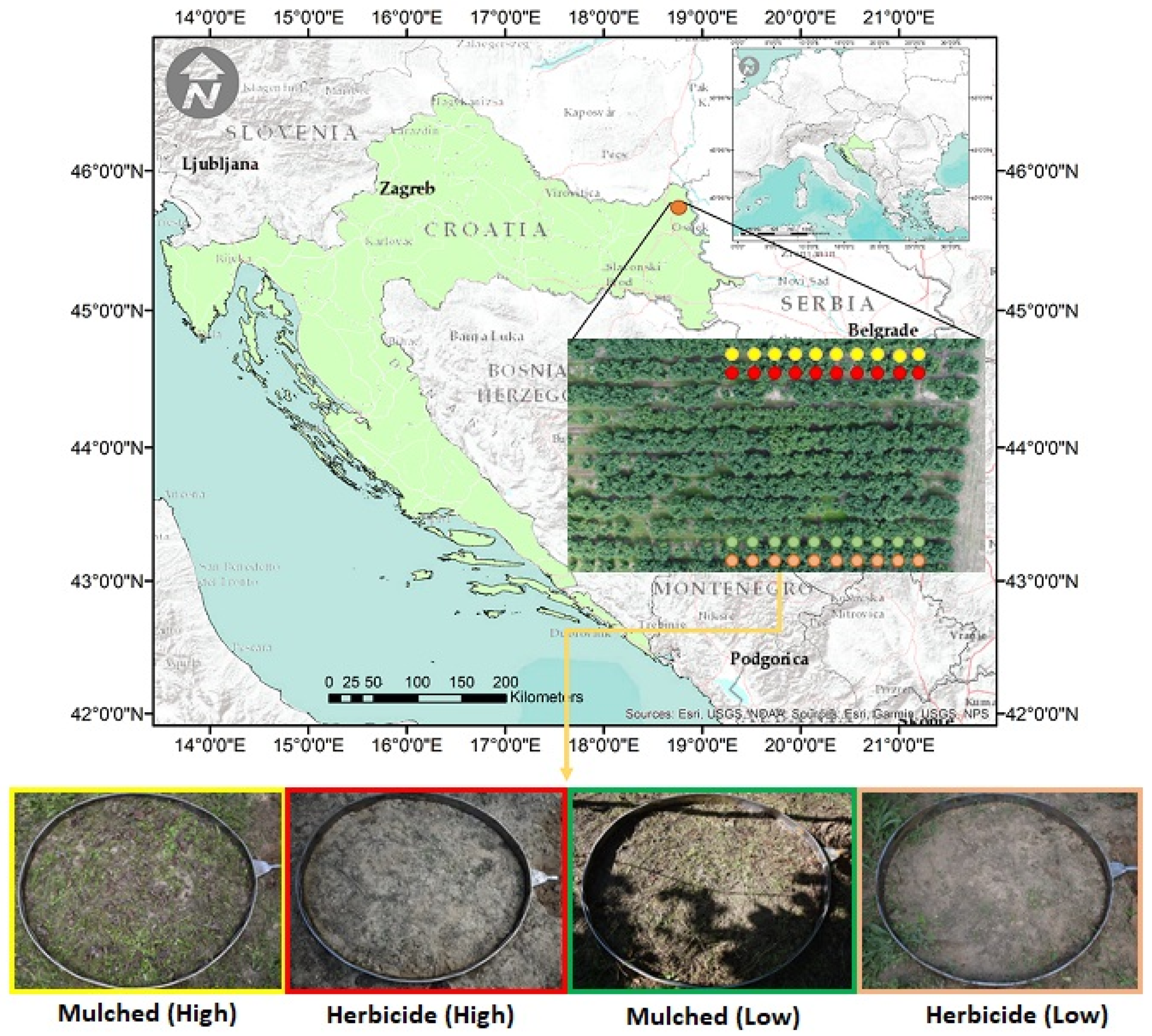

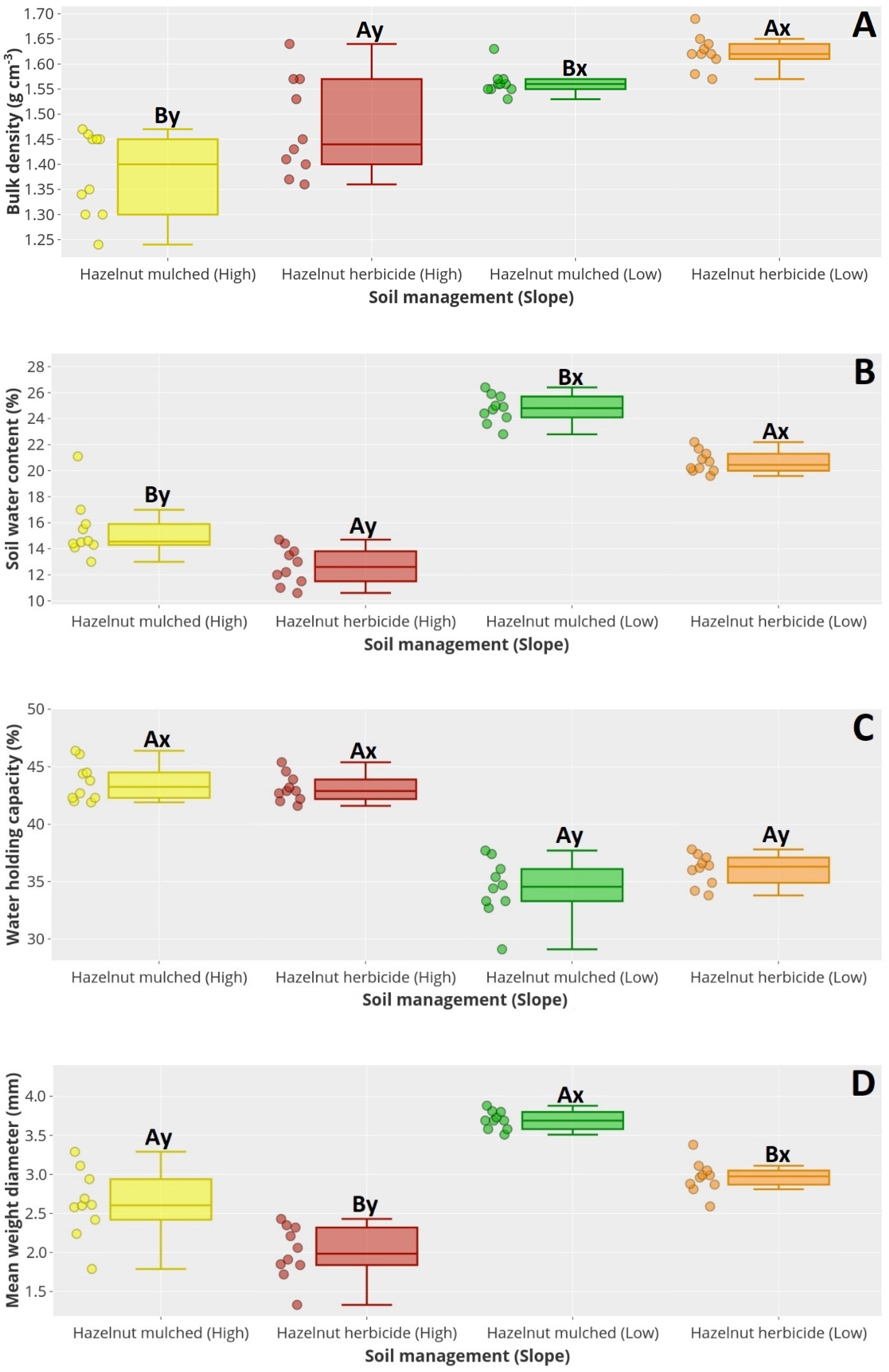
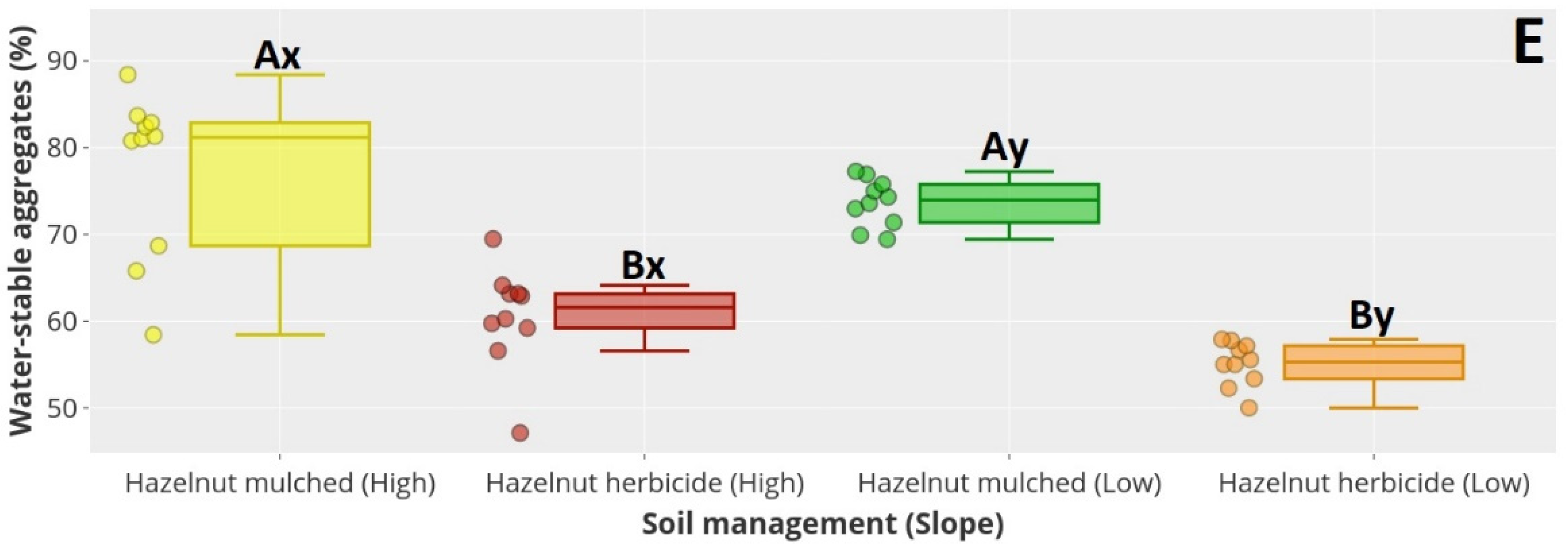
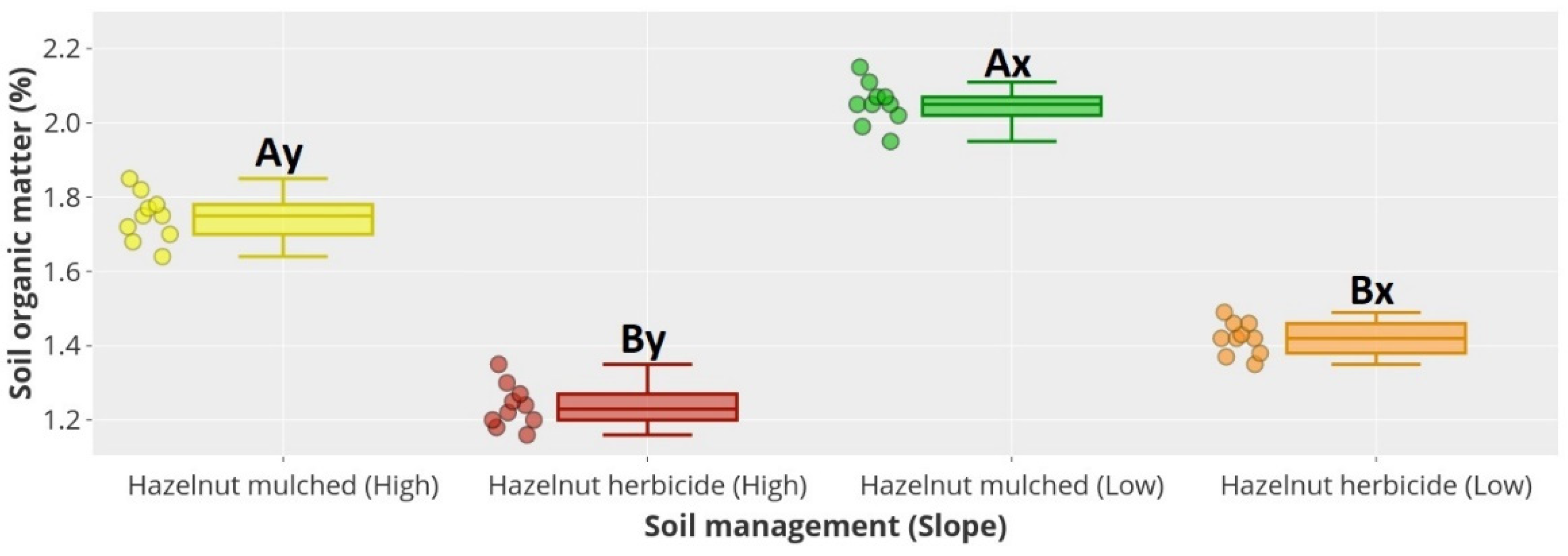


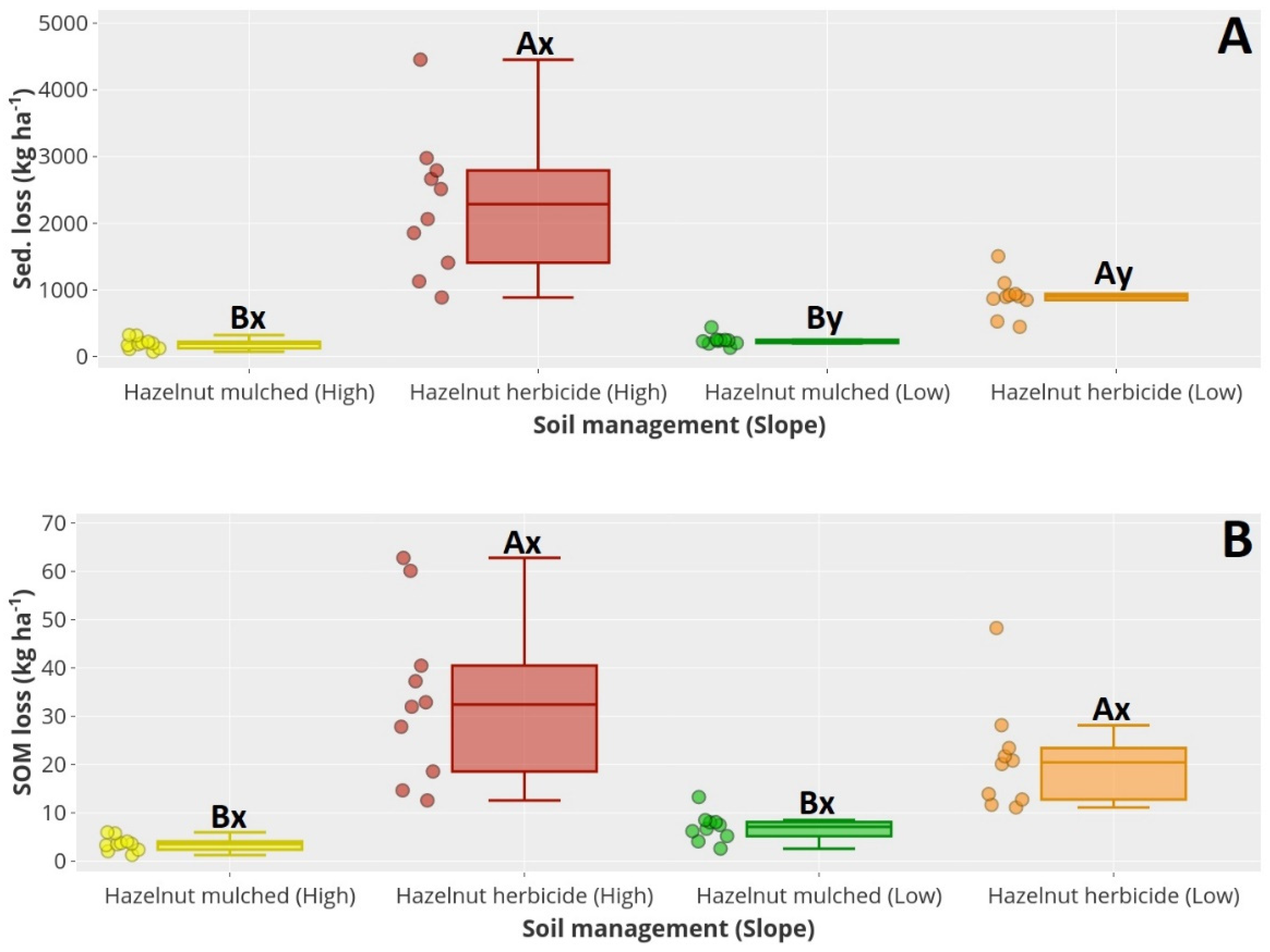

Publisher’s Note: MDPI stays neutral with regard to jurisdictional claims in published maps and institutional affiliations. |
© 2021 by the authors. Licensee MDPI, Basel, Switzerland. This article is an open access article distributed under the terms and conditions of the Creative Commons Attribution (CC BY) license (http://creativecommons.org/licenses/by/4.0/).
Share and Cite
Telak, L.J.; Dugan, I.; Bogunovic, I. Soil Management and Slope Impacts on Soil Properties, Hydrological Response, and Erosion in Hazelnut Orchard. Soil Syst. 2021, 5, 5. https://0-doi-org.brum.beds.ac.uk/10.3390/soilsystems5010005
Telak LJ, Dugan I, Bogunovic I. Soil Management and Slope Impacts on Soil Properties, Hydrological Response, and Erosion in Hazelnut Orchard. Soil Systems. 2021; 5(1):5. https://0-doi-org.brum.beds.ac.uk/10.3390/soilsystems5010005
Chicago/Turabian StyleTelak, Leon Josip, Ivan Dugan, and Igor Bogunovic. 2021. "Soil Management and Slope Impacts on Soil Properties, Hydrological Response, and Erosion in Hazelnut Orchard" Soil Systems 5, no. 1: 5. https://0-doi-org.brum.beds.ac.uk/10.3390/soilsystems5010005




